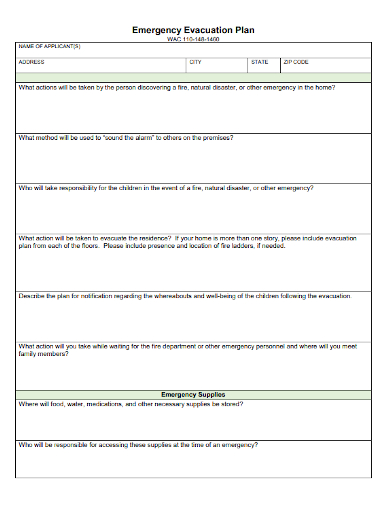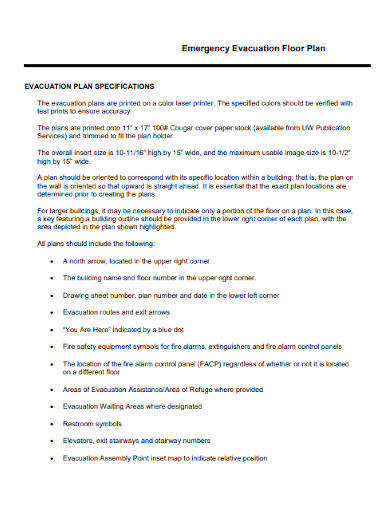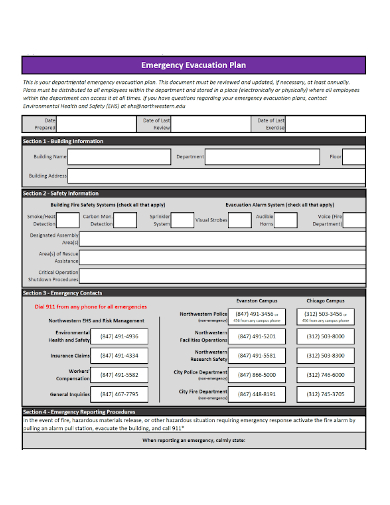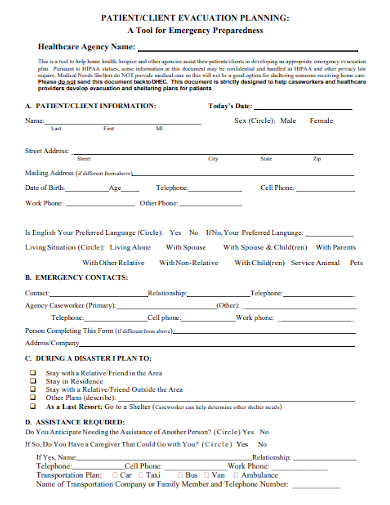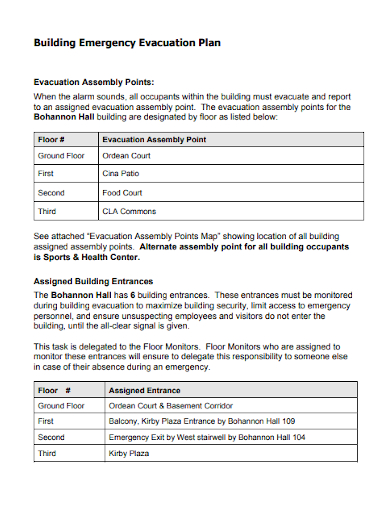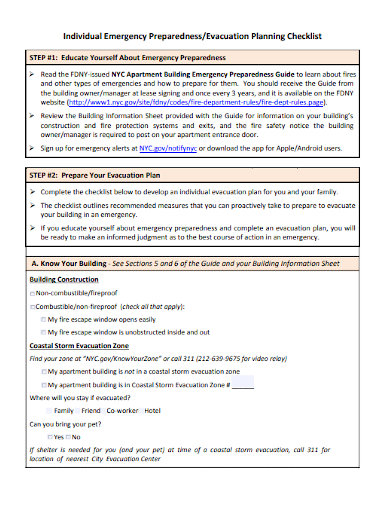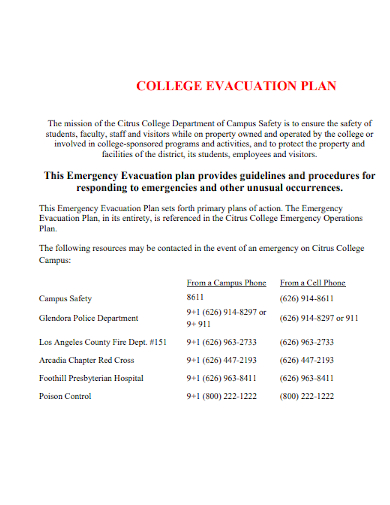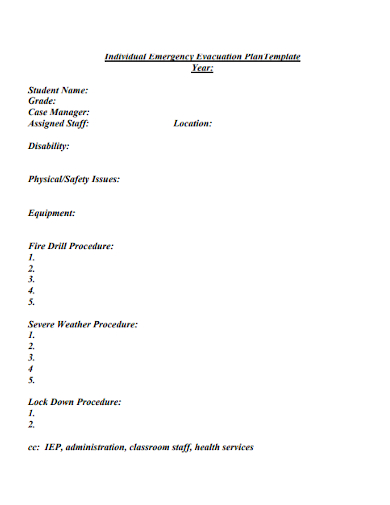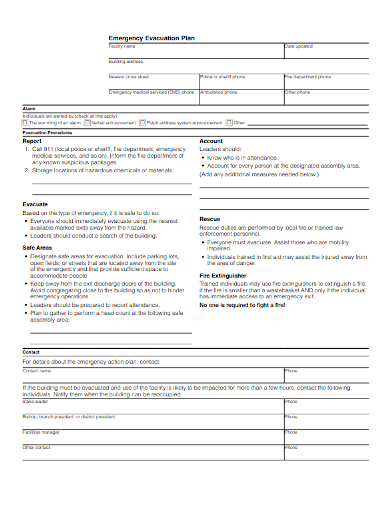Emergencies are always unpredictable and unreliable. Disasters such as floods, earthquakes, tornados, typhoons, fires, or terrorist activities can definitely disrupt the normal lives of everyone exposed to it making them and their belongings and properties more vulnerable to suffering the ugly consequences of these disasters emergencies can do. When teaching the right way on how to respond to emergencies, it is taught that people should evacuate the premises they are currently located if the situation escalates and the place they are in is no longer safe to stay. To ensure everyone’s safety and success in evacuating to a safer area, an efficient evacuation plan should be made with different types of evacuation procedures listed to deal with different types of emergencies. This article will guide you on how to make an emergency evacuation plan.
10+ Emergency Evacuation Plan Samples
1. Emergency Evacuation Plan Template

2. Basic Emergency Evacuation Plan
3. Emergency Evacuation Floor Plan
4. Emergency Evacuation Plans and Exercises
5. Emergency Patient or Client Evacuation Plan
6. Building Emergency Evacuation Plan
7. Security & Emergency Management Evacuation Plan
8. Individual Emergency Evacuation Planning Checklist
9. College Emergency Evacuation Plan
10. Editable Individual Emergency Evacuation Plan
11. Church Emergency Evacuation Plan
What Is An Emergency Evacuation Plan?
An emergency evacuation plan is a comprehensive written document that describes all the threats of emergency disasters, whether natural or man-made, that might occur and outlines the procedures on what to do during these emergencies. The plan should be developed to be specific on a certain site, such as it is developed for certain property or building, and should cover the following elements:
- Evaluation of emergencies
- Proper evacuation policies and procedures
- Emergency reporting mechanisms
How to Make an Emergency Evacuation Plan
1. For Businesses
- Determine evacuation procedures and emergency escape route: Floor map diagrams should be visibly posted throughout the establishment’s building such as putting those on each floor/area of the building. Mark the locations of exits, assembly points, and emergency equipment like fire extinguishers and first aid kits. Emergency exit routes should always be well lit, and wide enough to accommodate people, clear of that will block the way.
- Implement a clear chain of command and designation of all personnel authorized to order an evacuation: To ensure that an evacuation is done in the best calm manner possible, there should be authoritative trained personnel to supervise and coordinate the people to ensure a safe evacuation. Let the employees know who the coordinator is and understand that they have the authority to make decisions in emergencies.
- Make procedures for all employees after an emergency evacuation: Designate assembly areas inside and outside of the buildings where employees could gather after evacuating the premises. Make sure they are all safely accommodated. The designated person should be designated to do a headcount and if people are missing, the person should take note of their names and the last known location where they are last seen.
2. For Families
- Plan your evacuation: The first thing to do is to identify where your family can go when an emergency may happen and you need to evacuate. Try to have more than one option for evacuation. Keep a list of the phone numbers and addresses of these locations and make sure everyone in your family has easy access to this information. Next, map out your primary routes and backup routes to your evacuation destinations just in case roads are blocked. Keep a physical map of your area just in case GPS satellite transmissions are not available. You can also set a designated place where your family members can meet just in case you were all separated before or during the emergency. Make sure the designated place is easily accessible.
- Plan what to take for evacuation: Prepare your emergency kit. The kit should have all important items needed for evacuation such as first aid kits, radio, flashlights, extra batteries, bottled water, and important documents, just to name a few.
- Make a home inventory: Listing down your home inventory is handy if you need to apply for disaster aid and insurance just in case your furniture and other belongings got destroyed from a disaster.
- Gather important documents: Keep your important documents in a safe place and at the same time accessible so you can gather them in the event of an evacuation. It’s a good idea to make digital copies of these documents as well.
- Practice how you will do the evacuation: To ensure your family members are prepared for a sudden evacuation, do a real-time test. Practice how you will get yourself and your family and your belongings into your car and go to your planned evacuation site. This will help you decide on tactics on what to do and what to bring. This will help guide you on how to be ready when a real emergency happens.
FAQs
What are ten items to include in an emergency kit?
- First aid kit: It’s important to have a first aid kit that can allow you to treat possible injuries and prevent infections especially if you don’t have immediate access to a clinic or hospital.
- Toiletries: Your emergency kit should have a supply of basic toiletries such as personal hygiene products.
- Water container: Have at least one gallon of water per person per day for at least three days. It’s also useful having a portable water container especially when the water supply is very limited.
- Flashlight: A flashlight is definitely handy especially when there is a power outage. It’s better to have some spare flashlight instead of relying on phone flashlights so you can save your phone’s battery life.
- Portable mini tool: Protable mini tool such as army knives is useful in a lot of ways. It can be used for eating, opening canned goods, cutting through clothing, etc.
- Whistle: Having a whistle to call rescuers’ attention to your location can do so much to save your life.
- Blanket: A blanket is also important to protect yourself. An ideal blanket to include in your kit is a lightweight portable blanket that is useful in both hot and wet conditions.
- Waterproof case: This type of case can protect your belongings from getting wet in case you might be exposed to rain or have to go through floods.
- Radio: Since cell sites can be down during disasters, it’s useful to have a radio that can keep you updated on relief and rescue efforts and updates of the disaster.
- Rope: Ropes are useful during emergencies. they can be used as a lifeline, rappelling from high places, building a shelter, securing items, etc.
What are the four types of evacuation?
The four types of evacuation procedures are:
- Stay in place
- Building evacuation
- Campus evacuation
- City evacuation
Once your evacuation plan is finalized, whether you use it for your business or your home, the plan should be reviewed annually and ensure that it is always up-to-date. If there are changes that need to be made, make sure to communicate all the updates and changes to your employees or your family members to ensure they will always be prepared in the event of an emergency. A good evacuation plan will guarantee the safety of all occupants in your home and the workplace building. To help you get started making the emergency evacuation plan, download our free sample templates above to use as your guide!
Related Posts
FREE 7+ Fashion Business Plan Samples in PDF
FREE 10+ Sprint Planning Samples In MS Word | Google Docs | PDF
FREE 10+ Wedding Planning Samples in MS Word | Apple Pages | Powerpoint | PDF
FREE 9+ Monthly Study Planner Samples in PSD | Illustrator | InDesign | PDF
FREE 9+ Sample Curriculum Planning Templates in PDF | MS Word
FREE 10+ Teacher Development Plan Samples in MS Word | Google Docs | Apple Pages | PDF
FREE 10+ Basketball Practice Plan Samples in PDF
FREE 12+ School Business Plan Samples in PDF | MS Word | Apple Pages | Google Docs
FREE 7+ Client Strategic Plan Samples in PDF | MS Word
FREE 11+ Trucking Business Plan Templates in PDF | MS Word | Google Docs | Pages
FREE 7+ Small Hotel Business Plan Samples PDF | MS Word | Apple Pages | Google Docs
FREE 14+ Bakery Business Plans in MS Word | PDF | Google Docs | Pages
FREE 4+ Yearly Lesson Plan Samples in PDF
FREE 50+ Strategic Planning Samples in Google Docs | Pages | PDF | MS Word
FREE 10+ Construction Project Plan Samples in MS Word | Google Docs | Apple Pages | PDF

